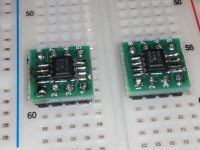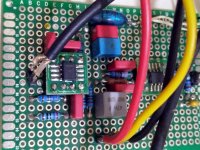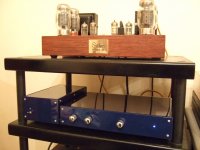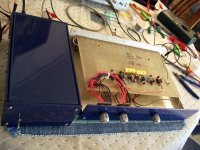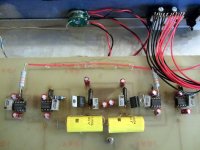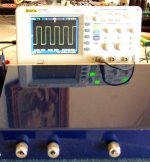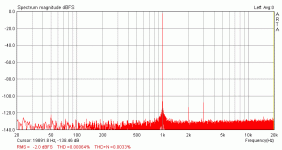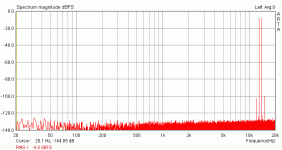Well, once I finalised the output stage options, as I want to integrate it with the B1 Korg and it is all part of a much bigger scheme 
Sadly things have gone mad here in F, after numerous protests last year with gillets jaunes, we moved on directly to massive strikes end of past year until recently... just to enter a virus aera where now working is getting very complicated, not mentioning taking care of children. My job is taking its toll and delaying my plans so much Nick, what a shame, but I guess in these hard times there are priorities and of course far more serious things than hobbies - I haven't started my beloved track car for 8 months, never had this in 2 decades.
Having said all that, I am glad I didn't test all the options on the Chipo directly, as that would have proved too much. Nick, I am stuck with the Class A bias, I hoped it would be straight forward but it didn't work so far, have to find out why. In the past I could easily find the right transistors to get 2.4mA bias just adjusting/chosing a resistor, but it seems the references of today aren't that well suited and for the first time in my life I even fried a transistor today! Argh... but at least I didn't mess up with the Chipo, so I am feeling far more confident splitting things that way.
But you are right, at the end I have probably already 99% of what is achievable with the Chipo, perhaps I should indeed just hook it up and listen (and wait possibly for better tweaking days), LOL!
I though felt I should post on my findings in case you guys want to improve further on that fine little device... oh, and find some nice op amps for who you know.
Report on its way...
Thanks again for reading me so fast
Claude
Sadly things have gone mad here in F, after numerous protests last year with gillets jaunes, we moved on directly to massive strikes end of past year until recently... just to enter a virus aera where now working is getting very complicated, not mentioning taking care of children. My job is taking its toll and delaying my plans so much Nick, what a shame, but I guess in these hard times there are priorities and of course far more serious things than hobbies - I haven't started my beloved track car for 8 months, never had this in 2 decades.
Having said all that, I am glad I didn't test all the options on the Chipo directly, as that would have proved too much. Nick, I am stuck with the Class A bias, I hoped it would be straight forward but it didn't work so far, have to find out why. In the past I could easily find the right transistors to get 2.4mA bias just adjusting/chosing a resistor, but it seems the references of today aren't that well suited and for the first time in my life I even fried a transistor today! Argh... but at least I didn't mess up with the Chipo, so I am feeling far more confident splitting things that way.
But you are right, at the end I have probably already 99% of what is achievable with the Chipo, perhaps I should indeed just hook it up and listen (and wait possibly for better tweaking days), LOL!
I though felt I should post on my findings in case you guys want to improve further on that fine little device... oh, and find some nice op amps for who you know.
Report on its way...
Thanks again for reading me so fast
Claude
Now to the listening impressions. This is just IMHO, I am NOT intending to classify op amps nor to start sterile discussions, my sole purpose here is to share my impressions and choices in hope to save others some time and cost when selecting parts. It is not an ABX test either, not that I am not a process man (Black Belt 6 Sigma and some interest in psychoacoustic), but fo those worrying I can tell I had really no way to read references on the tiny SMD devices without some time and a big magnifying glass and as far as I was concerned there were merely positions in different compartiments until I wrote all this. OK, perhaps my subconscience noticed the OPA because it was green and not brown (although my conscence had forgotten about which one it was LOL), and the LTs could be identified (only) together from the lot as being large size vs SMD… but well…
Note noise can be both background noise and different PS rejection as I used an average SMPS.
5532
Just for reference, good old one I have since decades. Noisy, bass has impact and reaches low but feels slow and not well defined, clarity is poor, airyness acceptable, highs seems rounded off and metalic, music doesn’t flow well and integration of all music registers is poor, as is imaging. It shows its age, wouldn’t recommend it today…I didn’t 20 years ago either !
LT 1169
Supposed to be kind of a modern upgrade. Bass is faster, treble much better, integration as a hole better, more details, flow is still average, still metalic sounding, bass reaches deep and is predominant. Wouldn’t really recommend it, there are better choices.
LT 1113
That’s the first unit that is acceptable. Integration and treble are better, bass is more differentiated / faster / more impulsive, it sounds less metalic, still mainly 2D imaging but it starts to get 3D, music flows and it is quite expressive around a somewhat rounded off nature. It is quite enjoyable but flow remains average, as are details. A possible option, easy fit in bi gold size op amps, well noting one can do better in all registers with other parts. Based on that I recognised the usual performance and sonic signature LT units had in the past, I could try a double LT1792 (SMD) but fear it won’t get me nowhere vs hassle so stopped there my LT exprience. This is a fit and forget 1 :1 part, just doing the job as a good work horse… no race horse though.
ADA4625-1
I had a lot of expectations on that one, as its spreadsheet reads as one of the best FET op amps around. And indeed it shone with less noise, excellent clarity, a lot of speed, a good integration of all registers and music instruments, treble seemed a bit pronounced and bass a bit dry and less diffenciated but still low reaching and very impulsive / fast. Music flows, spacialty is good, airiness aswell with lot of atmosphere, it is enjoyable ! It though sounds a bit too clean/dry, not metalic though. Listening long term revealed it could be less relaxed and less enjoyable than his smaller (warmer) brother, the ADA4627-1. At the end this is one that could fit if one needs or wants a very fast and clean sound while not sounding too sterile. Still on the dry side for me.
ADA4627-1
I had very low expectations on that one as basicaly it is supposed to be a lower grade ADA4625-1. Well, it is not in audio terms IMHO ! It does nearly all the the ADA4625-1 does… but better, much better in terms of musicality ! The bass is not as dry while still fast, details are still present, integration and tonality are excellent, it doen’t sound as dry and is rather on the neutral / warm side with lot of expressivity. Speed, flow, end of notes, great atmosphere, 3D spaciality, fun factor, body and flesh : all very good to excellent. Treble could perhaps be a tad more precise. This is a top op amp, one of the best I ever heard and TBH it has my recommandation. This is a keeper, will go to the final choice for the Chipo. Of course one has to ear how it matches there, and of course in conjunction with the cartridge and listener’s taste, but there is little not too love so far on that ADA4627-1. In a perfect world, I still could wish even more impact in the bass (a tad) and even more precise / cleaner high tones (treble), and it can never be fast enough on impulses (perhaps the ADA4625-1 feels even faster, light speed probably). These are attributes I have seen when biasing in Class A some op amps in the past, but then they have to be sensitive to this tweak. So there is still hope that an already outstanding op amp can even improve, nothing to lose trying… First on list so far, it is so enjoyable including long time on average records.
AD825
Yep, an old candidate, my favourite for past decades, but only when biased in Class A (it reacts very positively to it). Wanted to assess it again, see how the world had moved on since. First impressions are the old lion is not dead, it has body, impact, integration is good, it is quite fast, neutral/warm and involving ! In comparison with the very best, it is less good in airiness / spaciality, music flows less, treble is a tad metalic sounding probably also because a bit less detailled. Soundstage is acceptably 3D but more frontal / projected and restricted vs the very best. Speed is good but the game as changed, that was in the past one of the fastest sounding one. BUT this AD825 has the ability, once biased at 2mA ish, to improve on all its weaker points. At that stage, it would be second choice, somewhere with the ADA4625-1, as today there are better options. BUT once in Class A it twill gain a lot of ground… let’s hear if enough !
OPA1656
In the past I have to say I prefered widely the AD precise sound vs the softer traditional TI sound. I used though the better TIs in output stages of middle class DACs as these benefitted from a a more round /warm presentation with less details, as that masked their weaknesses and in fact improved the situation. It did not to my ears when having higher quality stuff and there AD’s speed, airiness, transparency shone, provided you avoided the bright ones. I tried this TI though because it was recommended here. And I must say that it differs from past TIs ! While not having that traditional « what people call old good tube sound », it is still a bit on the warm and musical side while being more more « open » than the TIs I knew. I found it had weight, impact, some airiness, a very good 3D soundstage, lot of details, noise is really very low, body of the instruments so enjoyable, an open treble that though tends a very small tad to the metalic side. This is also a keeper, probably one of the very best high quality all rounder provided you like it a tad warm. This one is also a potential final choice for the Chipo IMHO. There is not much not to like ! I feel it is though still a bit on the dark side, I tend to miss some bass tone differenciations and also the diabolical overall speed/agility from the top AD op amps. That one plays more to the ground, which could be a plus depending on your records and tastes. It is a tad less refined though than the ADA4627-1. Can it improve (mainly open up a bit) if biased in class A ? That is an unkown to be checked…
Note noise can be both background noise and different PS rejection as I used an average SMPS.
5532
Just for reference, good old one I have since decades. Noisy, bass has impact and reaches low but feels slow and not well defined, clarity is poor, airyness acceptable, highs seems rounded off and metalic, music doesn’t flow well and integration of all music registers is poor, as is imaging. It shows its age, wouldn’t recommend it today…I didn’t 20 years ago either !
LT 1169
Supposed to be kind of a modern upgrade. Bass is faster, treble much better, integration as a hole better, more details, flow is still average, still metalic sounding, bass reaches deep and is predominant. Wouldn’t really recommend it, there are better choices.
LT 1113
That’s the first unit that is acceptable. Integration and treble are better, bass is more differentiated / faster / more impulsive, it sounds less metalic, still mainly 2D imaging but it starts to get 3D, music flows and it is quite expressive around a somewhat rounded off nature. It is quite enjoyable but flow remains average, as are details. A possible option, easy fit in bi gold size op amps, well noting one can do better in all registers with other parts. Based on that I recognised the usual performance and sonic signature LT units had in the past, I could try a double LT1792 (SMD) but fear it won’t get me nowhere vs hassle so stopped there my LT exprience. This is a fit and forget 1 :1 part, just doing the job as a good work horse… no race horse though.
ADA4625-1
I had a lot of expectations on that one, as its spreadsheet reads as one of the best FET op amps around. And indeed it shone with less noise, excellent clarity, a lot of speed, a good integration of all registers and music instruments, treble seemed a bit pronounced and bass a bit dry and less diffenciated but still low reaching and very impulsive / fast. Music flows, spacialty is good, airiness aswell with lot of atmosphere, it is enjoyable ! It though sounds a bit too clean/dry, not metalic though. Listening long term revealed it could be less relaxed and less enjoyable than his smaller (warmer) brother, the ADA4627-1. At the end this is one that could fit if one needs or wants a very fast and clean sound while not sounding too sterile. Still on the dry side for me.
ADA4627-1
I had very low expectations on that one as basicaly it is supposed to be a lower grade ADA4625-1. Well, it is not in audio terms IMHO ! It does nearly all the the ADA4625-1 does… but better, much better in terms of musicality ! The bass is not as dry while still fast, details are still present, integration and tonality are excellent, it doen’t sound as dry and is rather on the neutral / warm side with lot of expressivity. Speed, flow, end of notes, great atmosphere, 3D spaciality, fun factor, body and flesh : all very good to excellent. Treble could perhaps be a tad more precise. This is a top op amp, one of the best I ever heard and TBH it has my recommandation. This is a keeper, will go to the final choice for the Chipo. Of course one has to ear how it matches there, and of course in conjunction with the cartridge and listener’s taste, but there is little not too love so far on that ADA4627-1. In a perfect world, I still could wish even more impact in the bass (a tad) and even more precise / cleaner high tones (treble), and it can never be fast enough on impulses (perhaps the ADA4625-1 feels even faster, light speed probably). These are attributes I have seen when biasing in Class A some op amps in the past, but then they have to be sensitive to this tweak. So there is still hope that an already outstanding op amp can even improve, nothing to lose trying… First on list so far, it is so enjoyable including long time on average records.
AD825
Yep, an old candidate, my favourite for past decades, but only when biased in Class A (it reacts very positively to it). Wanted to assess it again, see how the world had moved on since. First impressions are the old lion is not dead, it has body, impact, integration is good, it is quite fast, neutral/warm and involving ! In comparison with the very best, it is less good in airiness / spaciality, music flows less, treble is a tad metalic sounding probably also because a bit less detailled. Soundstage is acceptably 3D but more frontal / projected and restricted vs the very best. Speed is good but the game as changed, that was in the past one of the fastest sounding one. BUT this AD825 has the ability, once biased at 2mA ish, to improve on all its weaker points. At that stage, it would be second choice, somewhere with the ADA4625-1, as today there are better options. BUT once in Class A it twill gain a lot of ground… let’s hear if enough !
OPA1656
In the past I have to say I prefered widely the AD precise sound vs the softer traditional TI sound. I used though the better TIs in output stages of middle class DACs as these benefitted from a a more round /warm presentation with less details, as that masked their weaknesses and in fact improved the situation. It did not to my ears when having higher quality stuff and there AD’s speed, airiness, transparency shone, provided you avoided the bright ones. I tried this TI though because it was recommended here. And I must say that it differs from past TIs ! While not having that traditional « what people call old good tube sound », it is still a bit on the warm and musical side while being more more « open » than the TIs I knew. I found it had weight, impact, some airiness, a very good 3D soundstage, lot of details, noise is really very low, body of the instruments so enjoyable, an open treble that though tends a very small tad to the metalic side. This is also a keeper, probably one of the very best high quality all rounder provided you like it a tad warm. This one is also a potential final choice for the Chipo IMHO. There is not much not to like ! I feel it is though still a bit on the dark side, I tend to miss some bass tone differenciations and also the diabolical overall speed/agility from the top AD op amps. That one plays more to the ground, which could be a plus depending on your records and tastes. It is a tad less refined though than the ADA4627-1. Can it improve (mainly open up a bit) if biased in class A ? That is an unkown to be checked…
Final choice so far is ADA4627-1 and OPA1656, 2 excellent OP amps with a lot of positive in common while proposing opposite flavours… and possibly the AD825 biased in Class A. I also wish to assess how these 2 modern contenders can improve / or not, once biased in Class A.
But that is for the moment troublesome, perhaps also one should just stick to the op amps as they are as that's far easier to integrate while being already very enjoyable.
Time this year isn't on my side anymore and perhaps, as Nick suggested, I should just enjoy the Chipo for now
Enjoy music very much
Claude
But that is for the moment troublesome, perhaps also one should just stick to the op amps as they are as that's far easier to integrate while being already very enjoyable.
Time this year isn't on my side anymore and perhaps, as Nick suggested, I should just enjoy the Chipo for now
Enjoy music very much
Claude
Couldn’t leave things as they were, in particular as Nick is right : it is time to progress on the final installation and – the heck- to hook the Chipo and enjoy it ! So despite times being difficult I needed to progress on this.
In particular there were these 2 excellent Op amps, having a lot of common but offering a slightly different music representation, perhaps the ADA4627-1 small additional airyness/lightness being a tad more seductive (while the OPA1656 groove can be addictive)… but which one is truer ?
I let the 2 op amps burn-in an additional 20h and decided to use my Ipod as source. Hardly HIFI, but the purpose was solely to be able to monitor things. The Ipod can just drive my Beyer to the right volume level, being the souce direct option. Then I can introduce the simple HP amp, adjust the volume on it, so any change to the music presentation comes from that test rig which is mainly a double op amp per channel.
After another 20h of burn-in sound is settled. TBH I can’t tell if it really improved after the initial 5h, as direct comparison is impossible, but my feeling is « negligeable if anything ». It used to burn-in initialy though, the first hour mainly and then slightly so.
This test revealed again how excellent both op amps are and that they have more similarities than differences. However, the ADA4627-1 sounded still a tad more open up, airy and with a higher tonality balance. But in comparison to the direct source it turned out it lightens and brightens things a tad. Ads sparkling, takes off weight. Sounds fun though, but less true to the source.
On the other hand, the OPA1656 turned out to be very very close to the source, neutral in fact. Its tonality and balance are true, details are what they are and its massive punch weight are the real ones. In fact it hasn’t really a dark balance : it has a neutral one and the ADA4627-1 chip is in fact a tad brighter, sparkles and shines a tad (and the ADA4625-1 I turned down becomes though quite bright in return).
This gives us options to adjust the tonal balance for the Chipo. If you want pure HIFI and an excellent component that is neutral and incredibly fun, then the OPA1656 is simply an amazing chip, probably state of the art. If you feel on the other hand your output stage needs a bit of extra sparkling, then the ADA4627-1 is a very valuable option… to help adjusting the tonal balance.
I am not sure one can do much better in terms of HIFI than the OPA1656, integrated chip or not (how the world has changed !) as long as it is correctly implemented and used, but let’s see if it reacts to Class A and gets even better, well bearing in mind that air for improvement is very very thin now, at least to my ears.
In particular there were these 2 excellent Op amps, having a lot of common but offering a slightly different music representation, perhaps the ADA4627-1 small additional airyness/lightness being a tad more seductive (while the OPA1656 groove can be addictive)… but which one is truer ?
I let the 2 op amps burn-in an additional 20h and decided to use my Ipod as source. Hardly HIFI, but the purpose was solely to be able to monitor things. The Ipod can just drive my Beyer to the right volume level, being the souce direct option. Then I can introduce the simple HP amp, adjust the volume on it, so any change to the music presentation comes from that test rig which is mainly a double op amp per channel.
After another 20h of burn-in sound is settled. TBH I can’t tell if it really improved after the initial 5h, as direct comparison is impossible, but my feeling is « negligeable if anything ». It used to burn-in initialy though, the first hour mainly and then slightly so.
This test revealed again how excellent both op amps are and that they have more similarities than differences. However, the ADA4627-1 sounded still a tad more open up, airy and with a higher tonality balance. But in comparison to the direct source it turned out it lightens and brightens things a tad. Ads sparkling, takes off weight. Sounds fun though, but less true to the source.
On the other hand, the OPA1656 turned out to be very very close to the source, neutral in fact. Its tonality and balance are true, details are what they are and its massive punch weight are the real ones. In fact it hasn’t really a dark balance : it has a neutral one and the ADA4627-1 chip is in fact a tad brighter, sparkles and shines a tad (and the ADA4625-1 I turned down becomes though quite bright in return).
This gives us options to adjust the tonal balance for the Chipo. If you want pure HIFI and an excellent component that is neutral and incredibly fun, then the OPA1656 is simply an amazing chip, probably state of the art. If you feel on the other hand your output stage needs a bit of extra sparkling, then the ADA4627-1 is a very valuable option… to help adjusting the tonal balance.
I am not sure one can do much better in terms of HIFI than the OPA1656, integrated chip or not (how the world has changed !) as long as it is correctly implemented and used, but let’s see if it reacts to Class A and gets even better, well bearing in mind that air for improvement is very very thin now, at least to my ears.
Ahem, so perhaps Nick foresaw all this by chosing to implement a double op amp to play with, instead of separating DC offset and output in single op amps... I begin to wonder how much he really knows 
Anyway, he proved right, as at the end a double can still be splitted in 2 single op amps, but not the other way round. So far the design proves to be perfect...
Claude
Anyway, he proved right, as at the end a double can still be splitted in 2 single op amps, but not the other way round. So far the design proves to be perfect...
Claude
As it happened I was watching a journalist's report from your city Paris on Greek TV when I saw your message. Times are difficult indeed. We are stopped on our tracks here too. See your Chipo sessions as an anti stress distraction. Our hobby linked to music has this positive side nonetheless. Stay safe and keep us posted.
Thanks Nick.
Well, there are more important things than hobboes at stake at the moment, but sadly my family had taken 1 week holidays... while I had taken 2, in hope to progress and get all my projects done while I could seat alone here.
To nil, difficult to do anything in a flat populated by the entire family inclusive a less than 2y old one full time at home rocking the walls, well that is other than from 10 to 11pm or so :-(
But then no drama either, let's relax and think about how to progress once we are out, it is an enjoyable hobby and even more enjoyable thanks to you and your projects.
Good luck on your side Nick
Claude
Well, there are more important things than hobboes at stake at the moment, but sadly my family had taken 1 week holidays... while I had taken 2, in hope to progress and get all my projects done while I could seat alone here.
To nil, difficult to do anything in a flat populated by the entire family inclusive a less than 2y old one full time at home rocking the walls, well that is other than from 10 to 11pm or so :-(
But then no drama either, let's relax and think about how to progress once we are out, it is an enjoyable hobby and even more enjoyable thanks to you and your projects.
Good luck on your side Nick
Claude
I soldered two on SMD/TH mini adapter boards and checked them out on the agricultural Chipomatic's output/servo stage. I had AD823s there before.
The OPA1656s did very well for offset, noise the same if bit better 1/F, little more THD at 1V output. Possibly bit harder to be driven from the passive Riaa's 50k Zo than the previous. Noise output is mainly governed by the upstream circuitry as its expected with the designed gain structure.
Sound is very nice. No big difference than with the AD823s. Maybe little more neutral and delineated if little less exciting. Overall very good in this role.
The OPA1656s did very well for offset, noise the same if bit better 1/F, little more THD at 1V output. Possibly bit harder to be driven from the passive Riaa's 50k Zo than the previous. Noise output is mainly governed by the upstream circuitry as its expected with the designed gain structure.
Sound is very nice. No big difference than with the AD823s. Maybe little more neutral and delineated if little less exciting. Overall very good in this role.
Attachments
Agricultural Chipo's response subtraction in ARTA from a mathematically derived RIAA curve saved in its mic compensation slot plots +/- 0.02dB average deviation for both channels between 100Hz and 15kHz. I remeasured it with the OPA1656 in place to make sure there's no anomaly with chips changing.
Your assembly I remember has filter caps tolerance of a somewhat rising trend in response (+0.25dB between 1-20kHz maybe?) so your impressions on preferred second stage op-amp type may vary a little. If fraction of dB FR trend is audible only because wide in range. Taste and system synergy comes into it also.
Anyways, progress is usually made in bursts not linearly, so take heart.
Your assembly I remember has filter caps tolerance of a somewhat rising trend in response (+0.25dB between 1-20kHz maybe?) so your impressions on preferred second stage op-amp type may vary a little. If fraction of dB FR trend is audible only because wide in range. Taste and system synergy comes into it also.
Anyways, progress is usually made in bursts not linearly, so take heart.
Hi Nick
0.02dB difference... whaou!
Yep, with mine one channel is 0.28dB according to your kind measurments. But I still have these additional caps to put on which can adjust gain and sound aswell... of course I won't get close to your built, but that's getting academic as I am already surprised and pleased by such a good result
There is OPA827 I haven't tried, this looks IMHO good on the paper, but is very small and I am not sure somewhere we hit a limit... unless you think differently of course.
Great job of yours again, I hope I will be able to finish mine nicely after the virus and also perhaps to compare it with commercial products, who knows... but it deserves to be known among the community!
Stay safe
Claude
0.02dB difference... whaou!
Yep, with mine one channel is 0.28dB according to your kind measurments. But I still have these additional caps to put on which can adjust gain and sound aswell... of course I won't get close to your built, but that's getting academic as I am already surprised and pleased by such a good result
There is OPA827 I haven't tried, this looks IMHO good on the paper, but is very small and I am not sure somewhere we hit a limit... unless you think differently of course.
Great job of yours again, I hope I will be able to finish mine nicely after the virus and also perhaps to compare it with commercial products, who knows... but it deserves to be known among the community!
Stay safe
Claude
ClaudeG said:I am not sure one can do much better in terms of HIFI than the OPA1656, integrated chip or not (how the world has changed !) as long as it is correctly implemented and used, but let’s see if it reacts to Class A and gets even better, well bearing in mind that air for improvement is very very thin now, at least to my ears.
And the similarly interesting OPA2156. Both parts are MOS based, and appear architecturally identical. A few performance specifications do differ somewhat, such as slew-rate and settling-time, slightly favoring the 2156 and input noise-current, slightly favoring the 1656. The most notable specification difference appears be the input offset voltage, which is twenty times lower for the OPA2156 (+/-25uV), versus OPA1656 (+/-500uV). However, it's difficult to conclude whether the OPA1656 is simply an OPA2156 with relaxed Vos spec.
I'am interested in reading your assessment of the sound character difference of the OPA1656 when externally biased deeper into class-A after you've tried it, ClaudeG.
Last edited:
Well, I did report on that already, but I in the OPA1656 section.
Verdict: it sounds better to my ears without Class A bias.
Interesting to note that AD825 responded very well to Class A bias, ADA4627-1 responded badly and OPA1656 wasn't a clear cut initialy but apart from a slightly better bass all was really worst despite 2 different tries (usual rig and then hardwired as suspected interferences)
All already reported elsewhere as not the right place here. I read somewhere that OPA827 would be a potential challenger to OPA1656 and would also react favourably to Class A, but now I would like to spend my time finding at least a prototype enclosure (read cookie box) and listening to the Chipo than fine tuning (other than adjusting the caps).
Bad times to progress though...
Claude
Thanks for reading me
Claude
Verdict: it sounds better to my ears without Class A bias.
Interesting to note that AD825 responded very well to Class A bias, ADA4627-1 responded badly and OPA1656 wasn't a clear cut initialy but apart from a slightly better bass all was really worst despite 2 different tries (usual rig and then hardwired as suspected interferences)
All already reported elsewhere as not the right place here. I read somewhere that OPA827 would be a potential challenger to OPA1656 and would also react favourably to Class A, but now I would like to spend my time finding at least a prototype enclosure (read cookie box) and listening to the Chipo than fine tuning (other than adjusting the caps).
Bad times to progress though...
Claude
Thanks for reading me
Claude
Just out of curiosity Nick, did you try the OPA1656 in mono or stereo configuration?
One of its forte is imaging etc. and that might not shine in mono. Having said that, if you love flesh on the bone and colours, AD825 in Class A might be the one.
Will have to determine in my HIFI my case preference as that might change depending whereas listening directly... or through B1 Korg, a colourfull pre in itself.
Stay safe Nick
Claude
One of its forte is imaging etc. and that might not shine in mono. Having said that, if you love flesh on the bone and colours, AD825 in Class A might be the one.
Will have to determine in my HIFI my case preference as that might change depending whereas listening directly... or through B1 Korg, a colourfull pre in itself.
Stay safe Nick
Claude
no love for opa637/627?
They are very good OPA chips but not handy in my Chipo because they are mono.
Actually your question brought me memories. I first noticed them in an early 90s Burr-Brown brochure. They had no career in audio at that point. Only available on special order from the official Greek importer. Very expensive chips back then.
But I decided to check them out. So I ordered four. Ouch! Two 627 two 637. I wanted to make a line preamp. They came in a month or so. I was also handed a 5 1⁄4 inch floppy. It was some documentation on MS-DOS. Never saw what exactly. Because I had an Amiga.
So I started the design. The electronic plan was 627 buffer stage --> Sfernice Cermet pot --> 637 gain stage both with offset trim. Six inputs and an extra selector for REC out to my SONY DAT deck.
My tools were a felt pen, blank paper, a Metex DMM and a Weller 25W wall powered iron. I draw and etched a board then cut Alu panels. It looked rough initially but I also had a finish concept. Automotive dark metallic paint and knobs from a Telecaster guitar.
I could not measure the performance but it sounded clean as a whistle. Kept it for long enough until new experiments came up, it ended up at a friend's system.
End of 2011 he brought it back for an overhaul. The pot had gone scratchy, the paint job had flaked off at places, one channel was coming and going on its own will.
The chassis got back panel reinforcement for new stronger RCAs and a new blue paint coat, the French pot was replaced with a Chinese stepper and the intermittence got traced down to a joint. New lease of life for the pre.

But this time I had a scope and FFT card for curiosity measurements before handing it back.
Attachments
Indeed interesting, impressive memory Nick!
And thanks for the reply...
Well, having 2 monos is not a problem in SMD format as I had that with all other op amps I tried but OPA1656 (AD825, ADA4627-1 etc.), but sadly I haven't 4 OPA627 to play with. I assumed OPA1656 would be a better bet and more modern/designed for, but who knows, just guessing work of course. And then ther is CMOS vs JFET, but that beats me anyway as not experienced in that.
I have lying somewhere 4 OPA827 to play with but these come in extra small SMD size and I haven't found satisfactory boards to make the try, so likely to end there unless someone else tests a better chip than OPA1656 for the Chipo, well noting there isn't probably a lot of improvement room at that level, but a bit more involvement in bass could potentialy still be nice indeed. I had OPA827 in mind because its spec sheet seemed to look better than OPA627, but then what are spec sheets (ADA4625-1 looked like a better ADA4627-1 following spec sheets and then the latter sounded clearly better for audio in my -limited- rig)
Thanks for all this sharing
Claude
And thanks for the reply...
Well, having 2 monos is not a problem in SMD format as I had that with all other op amps I tried but OPA1656 (AD825, ADA4627-1 etc.), but sadly I haven't 4 OPA627 to play with. I assumed OPA1656 would be a better bet and more modern/designed for, but who knows, just guessing work of course. And then ther is CMOS vs JFET, but that beats me anyway as not experienced in that.
I have lying somewhere 4 OPA827 to play with but these come in extra small SMD size and I haven't found satisfactory boards to make the try, so likely to end there unless someone else tests a better chip than OPA1656 for the Chipo, well noting there isn't probably a lot of improvement room at that level, but a bit more involvement in bass could potentialy still be nice indeed. I had OPA827 in mind because its spec sheet seemed to look better than OPA627, but then what are spec sheets (ADA4625-1 looked like a better ADA4627-1 following spec sheets and then the latter sounded clearly better for audio in my -limited- rig)
Thanks for all this sharing
Claude
Last edited:
- Home
- Source & Line
- Analogue Source
- Chipomatic balanced input RIAA
